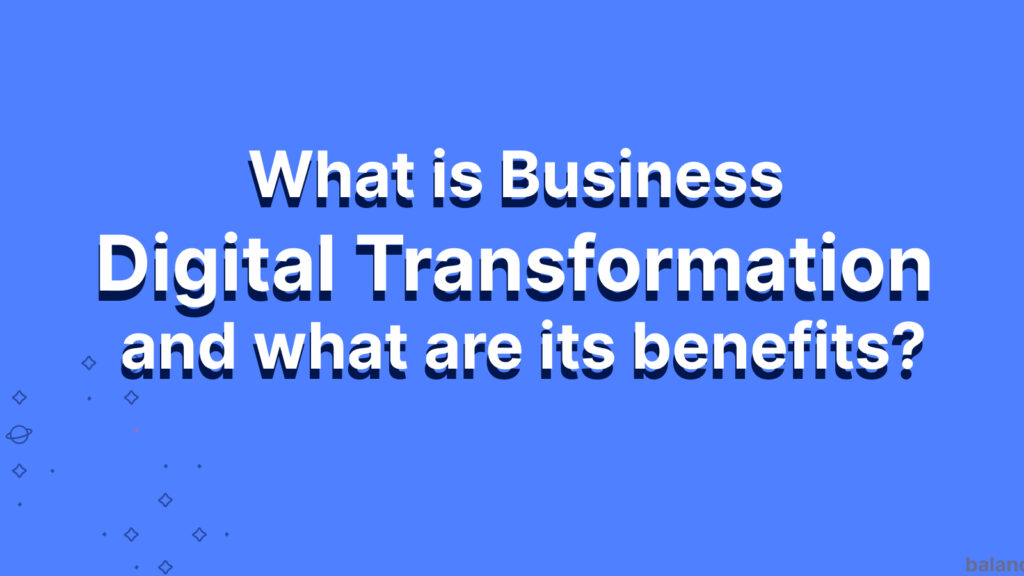There are different points of view regarding business digital transformation but in essence it refers to the adoption of digital and innovative technologies to improve one or more processes.
When you finally decide to take the first steps into digital transformation, you realize that rethinking your tech stack implies evaluation of the customer journey as well as the employee’s experience as part of the process. This is because they are all going to be involved in any business’s value proposition delivery.
Can digital transformation be applied in any business?
Business Digital Transformation can be applied on many levels and in companies of any size. All systems, processes, workflows and culture can (and should) be involved in the transformation since it impacts every level of an organization and it helps collect information from all the areas to work in synergy and more effectively.
Some younger industries or businesses can be easily turned into an even more digitized version of themselves. For those that are not digital yet, the transformation can take a bit longer since there are legacy processes and tools that may take a while to replace. It’s also important to keep in mind the team’s training so that the whole company can adapt and take full advantage of the digital transformation.
The situation is different for those who are just starting. Although some may think this as a very risky moment and scenario to begin a project from scratch, in a certain way the context sets them a step ahead of those companies that need to redesign most of their processes.
Five Benefits of Digital Transformation in different business areas
For some companies the main trigger for digital transformation is cost-related since lots of inherited processes may not be as efficient as an organization needs. Here are some of the benefits of applying digitalization to different areas and industries.
1. Data collection and analysis.

Collecting customer data is currency in some businesses, yet the correct organization and analysis of this information is what really benefits a business, by enabling data driven decisions.
It’s key to assess how data is collected, stored and analyzed. By better understanding customers and their needs, business, marketing and communication strategies that are even more customer-centric can be created.
We can see examples of data use opportunities enabled by digital transformation in the fitness industry. There are social apps focused on communities that gather behavioural information on specific sports. Apps like Strava that promotes in-app activity by “peer to peer” interaction and gamification. This sort of feature can be applied in different businesses related to fitness, such as gyms, sports clubs, sporting goods. Gathering information about customers’ activity can help understand trends on their consuming and behaviour habits to design better products and offers for them.
2. Raise profits

Organizations that face digital transformation can see a clear boost in efficiency and profitability. As can be seen on some interesting numbers provided by the SAP Center for Business Insights and Oxford Economics:
- 80% of companies that completed digital transformation report increased profits.
- 85% increased their market share.
Profit and market share increase are often related to digital transformation applied in Marketing and Sales. Converting conventional sales funnels into digital customer journeys implementing the proper technology to accomplish it is one of the main reasons organizations achieve a better ROAS (Return on ad spend). Automating communication flows and seeing real time results of the impact every ad created, helps Marketing departments optimize their strategies .
3. Better customer experience

Consider how your digital transformation can not only unlock efficiencies for your teams, but also deliver more seamless, intuitive experiences for your customers. Customer experience (CX) is the new battleground for brands. Gartner reports that more than two-thirds of companies say they are competing mostly on customer experience.
According to a study ran by S&P Global (2022 Trends in Applied Infrastructure & DevOps):
“Improving the user experience of applications and services is the main result sought by organizations that implement DevOps (53%). DevOps has quickly gone from being an IT philosophy and organizing principle to a strategic business imperative targeting the KPIs that matter most in the C-suite.”

4. Encourages digital culture (Improving collaboration and productivity)
By providing team members with the right tools, tailored to their environment, digital transformation encourages a digital culture and more collaborative work interactions.
Having the right tools working in synergy can streamline workflow and improve productivity. By automating many manual tasks and integrating data throughout the organization, team members can be empowered to work more efficiently.
This is a clear opportunity to implement communication tools like Slack in the workplace that can be easily integrated with file sharing apps like Dropbox or with planning/tracking tools like Airtable, enhancing the work experience and the democratization of information.
5. Increased agility

Digital transformation turns traditionally structured companies into agile organizations. Based on software development principles, businesses can multiply their agility improving speed-to-market and adopting Continuous Improvement (CI) strategies.
This grants faster innovation and adaptability as well as providing a pathway to improvement in areas like supply chain management. Some systems are using a combination of AI (artificial intelligence) and ML (machine learning) in ERP (Enterprise Resource Planning) to generate demand forecasting by analyzing latest buying trends and comparing them against future projections.
Manufacturing is an area where inventory management is a pressing issue and in which technologies like computer vision could significantly improve some operations by providing a system that helps categorize items produced. Also some organizations are implementing this kind of technology in the delivery of products to its final users, such as self served payments.
So, the last question left to answer would be:
- Which of the benefits of Digital Transformation are you looking for in your business?
- Do you know how to get there?
If you enjoyed this post, or have an idea or are working on a project you could use some help with, feel free to contact us! We’d be happy to help you… or who knows? Maybe be your new partner in crime.
If you have an idea or are working on a project you could use some help with, feel free to contact us! We’d be happy to help you… or who knows? Maybe be your new partner in crime.
You enjoyed this post and want to read more?
